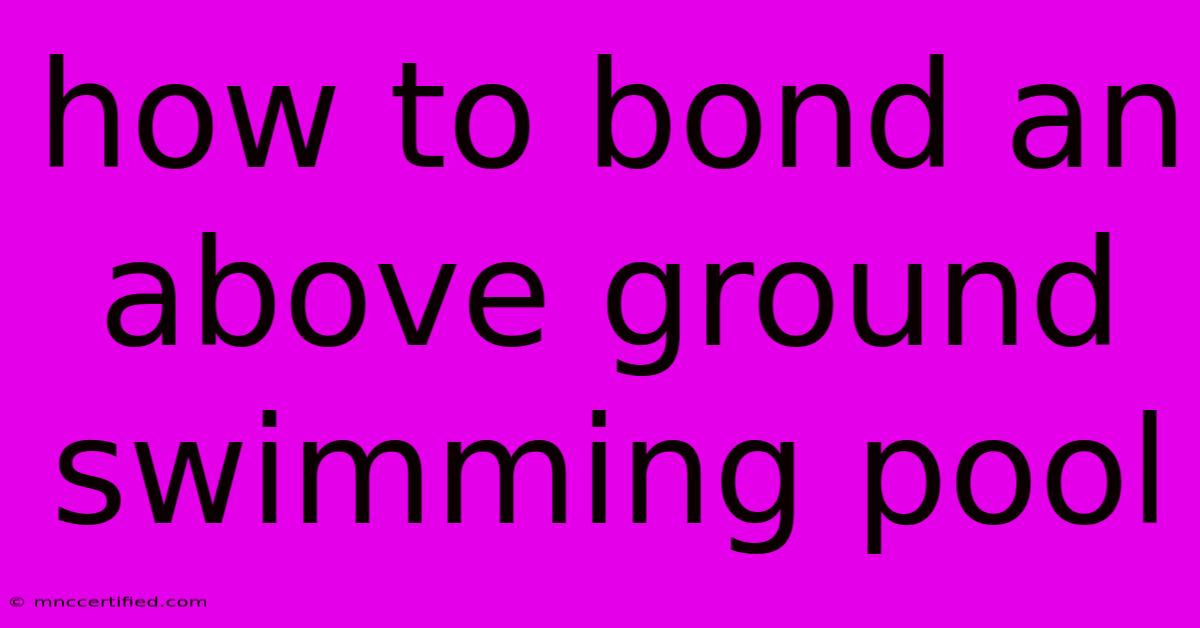How To Bond An Above Ground Swimming Pool

Table of Contents
How to Bond an Above Ground Swimming Pool: A Step-by-Step Guide
An above ground pool is a fantastic addition to any backyard, offering endless fun and relaxation during the warm months. However, ensuring your pool is properly bonded is crucial for safety and longevity. Bonding helps prevent corrosion and ensures the pool's electrical system operates correctly. This guide will walk you through the process of bonding an above ground swimming pool.
Why Bond Your Pool?
Bonding your pool is a critical safety measure that prevents electrical shock hazards. Here's why:
- Electrical Grounding: Bonding connects all metal components in the pool, creating a single, unified electrical path. This ensures that if a fault occurs in the electrical system, the current is directed to the ground, preventing electrical shocks.
- Corrosion Prevention: By providing an electrical path, bonding helps prevent galvanic corrosion. This occurs when different metals in contact with each other and water create an electrochemical reaction, leading to metal deterioration.
Materials You'll Need:
- Bonding Wire: Typically 6 or 8 AWG copper wire, with a minimum length of 10 feet.
- Bonding Clamps: Securely attach the bonding wire to metal components.
- Wire Connectors: For joining the wire to the ground rod.
- Ground Rod: A 10-foot copper-clad steel rod, driven deep into the ground to provide an earth connection.
- Voltmeter: To test the bonding circuit and ensure proper continuity.
- Tools: Screwdriver, wire cutters, pliers, hammer, and a level.
Step-by-Step Instructions:
-
Locate and Identify Metal Components:
- Pool Structure: The pool's metal frame, ladder, handrails, and any other metallic parts.
- Electrical System: Motor, pump, filter, lighting, and other electrical equipment.
- Water Line: The metal water line that connects the pool to the plumbing system.
-
Connect the Bonding Wire:
- Attach to Ground Rod: Connect one end of the bonding wire to the ground rod using a wire connector.
- Install the Ground Rod: Drive the ground rod into the ground as deep as possible, ideally 8 to 10 feet, ensuring it's located within 5 feet of the pool. Use a level to ensure the rod is straight.
- Connect to the Pool: Run the bonding wire from the ground rod to the pool's metal components. Securely attach the bonding wire to each component using bonding clamps.
-
Test for Continuity:
- Connect the Voltmeter: Use a voltmeter to test for electrical continuity between each metal component and the ground rod.
- Verify Bonding: If the voltmeter reads zero ohms, you have a successful bond. If not, check the connections and ensure the wire is properly attached.
Additional Tips:
- Keep it Simple: Follow the manufacturer's instructions for bonding your specific pool.
- Inspect Regularly: Inspect the bonding system periodically to ensure all connections are secure and corrosion-free.
- Consult a Professional: If you're unsure about any part of the process, contact a qualified electrician to help you bond your pool correctly.
Conclusion:
Bonding your above ground pool is an essential step in ensuring safety and preventing electrical hazards. By following these steps, you can ensure your pool is properly grounded and operating correctly. Remember to always prioritize safety and consult a professional if needed. Happy swimming!

Thank you for visiting our website wich cover about How To Bond An Above Ground Swimming Pool. We hope the information provided has been useful to you. Feel free to contact us if you have any questions or need further assistance. See you next time and dont miss to bookmark.
Featured Posts
-
Knights Of Columbus Life Insurance Reviews
Nov 07, 2024
-
Donald Trump Inauguration Date And Facts
Nov 07, 2024
-
Sf Mayoral Race Breed Faces Challenges
Nov 07, 2024
-
Hix Insurance In Burlington North Carolina
Nov 07, 2024
-
Algorithmic Trading A Practitioners Guide
Nov 07, 2024